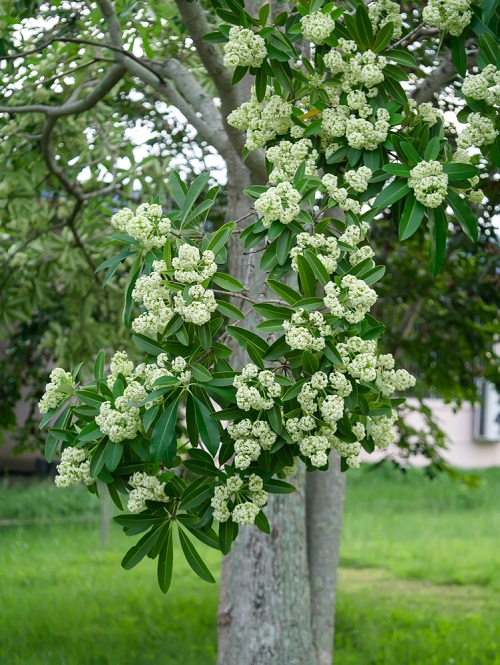
Alstonia scholaris
-Indian devil tree
- Alstonia scholaris, commonly called blackboard tree, Scholar Tree, Milkwood or devil's tree in English,[3] is an evergreen tropical tree in the Dogbane Family (Apocynaceae). It is native to southern China, tropical Asia (mainly the Indian subcontinent and Southeast Asia)and Australasia, where it is a common ornamental plant. It is a toxic plant, but is used traditionally for myriad diseases and complaints.
- The Indian devil tree is a medium-sized evergreen tree that can grow up to a height of 40 meters. It has a straight trunk and a broad canopy of glossy green leaves. The tree produces white, fragrant flowers that bloom in clusters and fruits that are long, narrow, and green in color. The bark of the tree is smooth, grayish-white, and contains a bitter sap that is used for medicinal purposes.
USES:-
- The Indian devil tree has a wide range of uses and benefits in various fields, including medicine, agriculture, and industry. The tree's bark, leaves, and roots are used in traditional medicine to treat various ailments such as fever, malaria, asthma, and cough.
- The sap of the tree is also used as a natural remedy for insect bites and skin allergies.
- The wood of the Indian devil tree is used to make furniture, paper pulp, and construction materials.
- The tree is also beneficial in soil conservation as it helps in preventing soil erosion and improving soil fertility.
- The wood of Alstonia scholaris has been recommended for the manufacture of pencils,
- as it is suitable in nature and the tree grows rapidly and is easy to cultivate.
- In Sri Lanka its light wood was used for coffins
- . The wood close to the root is very light and of white colour, and in Borneo was used for net floats, household utensils, trenchers, corks, etc. In Theravada Buddhism,
Cultural & Historical Importance:
- The Indian devil tree holds great cultural and historical significance in India. The tree is considered sacred in Hindu mythology and is associated with Lord Shiva.
- It is believed that the tree has the power to ward off evil spirits and bring good luck and prosperity.
- The Indian devil tree is also mentioned in various ancient Indian texts, such as the Ramayana and the Mahabharata.
- According to Brahma Purana, the land of Utkal, Orissa is holy. The land is said to bless its people salvation and absolve them of all the sins. The land is one of the rarest holy centres. The land of Utkal contains several sacred trees and one such tree is Saptaparna.
- In Buddhism, Saptaparna is known as the Man-plant, meaning seven principled human being.
- SaptaParna is also the name of a cave of seven chambers where the Gautama Buddha taught esoteric truths to his select disciples- Arhats. The cave is located near Mount Balibhar, Rajagriha, the ancient capital of Magadha. It is the place where the first Buddhist council was held during the reign of the King Ajatashatru.
- In Atharva Veda, it is mentioned that the tree is used in the preventive and curative diseases caused due to seasonal changes.
Plantation:-
- Watering
Alstonia scholaris prefers well-drained soil that is moist but not waterlogged. It is important to water the tree regularly, especially during the first few years after planting. During hot and dry weather, the tree should be watered more frequently to ensure that the soil stays moist. However, over-watering should be avoided as it can cause root rot and other fungal diseases.
- Temperature
Alstonia scholaris thrives in warm temperatures and can tolerate temperatures between 15°C to 45°C. However, the tree is sensitive to frost and cannot tolerate freezing temperatures. Therefore, it is important to plant the tree in a location where it is protected from cold winds and frost.
- Fertilizers
Alstonia scholaris requires regular fertilization to promote healthy growth and development. A balanced fertilizer that contains nitrogen, phosphorus, and potassium can be applied every six months. Organic fertilizers such as compost and manure can also be used to enrich the soil.
- Soil
Alstonia scholaris prefers well-drained soil that is rich in organic matter. The soil should be slightly acidic with a pH between 5.5 to 7.5. The tree can tolerate a wide range of soil types, including sandy, loamy, and clayey soils. However, the soil should be free from any contaminants or pollutants.
- Pruning
Pruning is an important aspect of Alstonia scholaris tree care. The tree should be pruned regularly to promote healthy growth, remove dead or diseased branches, and shape the tree. Pruning should be done during the dormant season, preferably in late winter or early spring. The tree should not be pruned during the growing season as it can result in stunted growth and reduced flowering.
- Conclusion
In conclusion, Alstonia scholaris is a tropical tree that requires regular watering, warm temperatures, balanced fertilizers, well-drained soil, and proper pruning. With proper care and maintenance, Alstonia scholaris can grow into a healthy and beautiful tree that provides shade, adds aesthetic value, and contributes to the environment.
